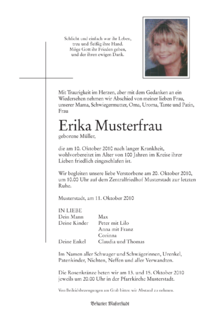Party
The party or the party slip is in Austrian usage the written notification of a family event, such as baptism, engagement, marriage or death. The word is derived from the French faire part ("to communicate") or thunder part ("to give message") and was probably created at the end of the 17th century. The party usually contains the place and time of the family event as well as possibly information about religious celebrations in connection with the event, such as B. Baptism , church wedding or soul mass . The party or the party slip is often wrongly used only for a written message about the death of a person, probably because this form is the most common.
On the one hand, it is sent to people who are to be invited to the event. B. as part of the death also publicly displayed in party boxes (for example at the cemetery entrance, at the undertaker in front of the house and in other showcases distributed throughout the community). Until the beginning of the 20th century, parties, especially those who died, were delivered personally by a servant or house officer. This is likely to be related to the hygienic conditions at the time, which made it necessary to bury the dead quickly, as there was no possibility of cooling. Sending the parcels by post usually took too long and was mostly unreliable.
The form and content of the news of death in particular have changed in line with contemporary tastes. Baptism, engagement and wedding announcements, however, still follow formal rules that were already in use in the 19th century. In the case of news of death in particular, it was customary to state the full name and degree of relationship of the bereaved. Today often only the first names are mentioned; the information content of these parties, especially for outsiders, is therefore to be classified as rather low. It was also customary to add a light blue border to death partners for children up to the age of twelve. To this day, wedding messages are usually sent on particularly strong paper, slightly larger than A5, which is folded in the middle. The parents of the groom on the left and the parents of the bride announce the impending marriage on the right (unless the bride and groom are of old age; in this case they indicate in their own name). These parts can be very elaborate, for example printed on hand-made cardboard using copperplate engraving.
